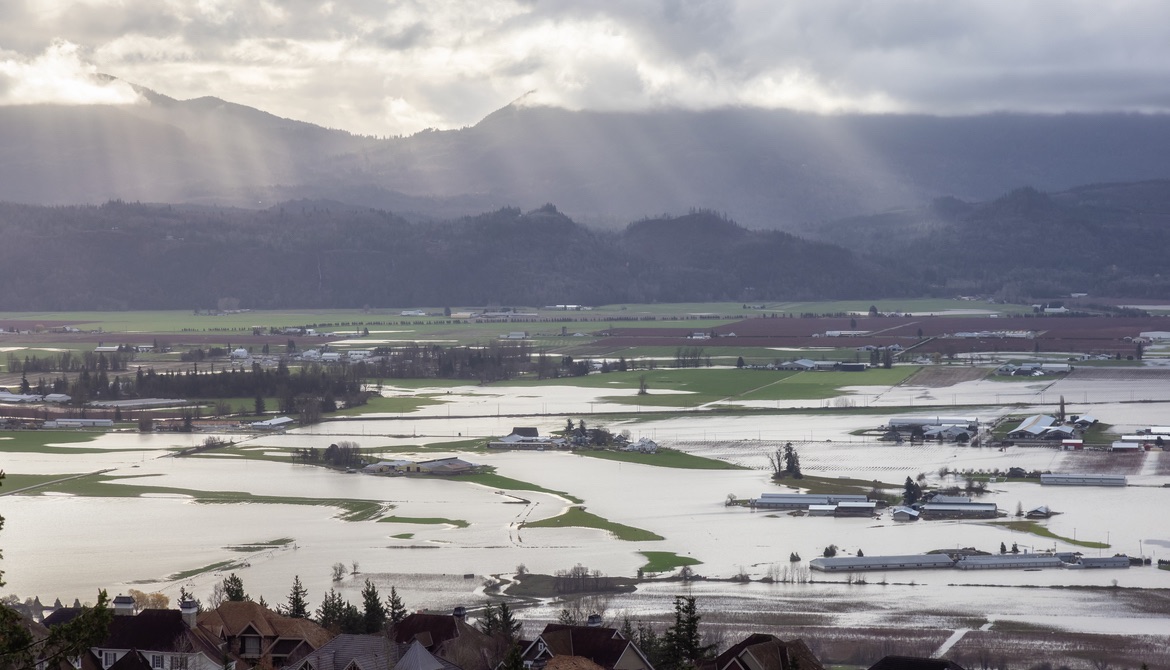13 minutes
As Canadian credit unions react to recent extreme weather, they prepare for the next disaster.
Credit union leader David Lanphear lives on a hill in Abbotsford, British Columbia, in the Fraser Valley, 70 kilometres southeast of Vancouver, not far from the American border.
Last November, Lanphear, the president of Envision Financial, was working from home when severe weather hit. The region was hit by five atmospheric rivers: blustery, warm, saturated bands of air hundreds of kilometres long and wide. The five were followed by a sixth atmospheric river of breathtaking intensity and longevity. For 48 hours—from Nov. 13 to15—the heavens opened and the waters rose.
“I looked down and you could see the water levels coming up in the farms and the fields,” Lanphear says. “As it worsened, my mind shifted to preparedness, and I suggested to my wife that we may need to stock up on some basic necessities and fill up the car. It spiralled from there—clearly this was more than just a big rainstorm.”
Soon, about 200 square kilometres of the Fraser Valley’s low-lying, fertile Sumas Prairie were flooded. In other parts of the province, bridges collapsed, highways were engulfed by mudslides, and houses were swept away by swollen rivers. About 15,000 people were forced to evacuate. At least 628,000 chickens, 420 cows and 12,000 pigs drowned.
Lanphear’s initial thoughts were for the safety of Envision’s staff, who live throughout the Fraser Valley, a region that begins near Hope and stretches 150 kilometres to Vancouver. Some were trapped outside the flood zone, unable to return to their homes due to blocked or destroyed roadways, says Lanphear, whose credit union is a division of $15.5 billion/250,000-member First West Credit Union, Langley, British Columbia.

After pinpointing the whereabouts of staff and ensuring their well-being, thoughts turned to members. Susan Coulson, director of special accounts at First West CU, says that the credit union identified more than 1,100 members with property in the flood zone. Staff connected with the members to ask how they could help. Out of those members, 86 were referred to Coulson’s special accounts team for support. Some people were stranded outside the flood area. Other members’ workplaces were shut down. Many had flooded houses. “We were talking to members who were standing in homes that had two feet of water,” says Coulson.
For nearly a week, the focus was on rescuing people and animals. When the water began to recede, the focus shifted to assessing damages. Homeowners were met with fetid detritus from backed-up sewers, farm manure, contaminants, and basements littered with rat, mice and rabbit carcasses. Since the Sumas Prairie is a floodplain, many members didn’t have flood insurance because it was too expensive or unavailable.
Coulson helps administer First West’s Back on Track program, which was started in 2010 to help members going through financial and life hardships. The 86 members heavily impacted by flood waters received relief through reduced or deferred payments on mortgages or loans, while others were offered remediation funds, she says.
Envision Financial extended a helping hand to the wider community, donating $100,000 to flood relief efforts, dividing it equally among the Canadian Red Cross, Abbotsford Community Foundation, Food Banks BC and the B.C. Agriculture Council. The credit union will donate additional money as the protracted construction, cleanup, remediation and restoration efforts continue, says Lanphear.
Credit unions across the country also lent a helping hand to BC residents, donating to local aid organizations or contributing to Central 1 Credit Union’s campaign that raised $286,545 for the Canadian Red Cross.
Canadian Credit Unions Join the Battle Against Climate Change
Change Is Here
Throughout the world, extreme weather events like BC’s floods are becoming more frequent and severe due to climate change. Last June, BC also endured temperatures that soared near 50 Celsius, causing 595 deaths and killing 650,000 farm animals. Like other financial institutions, credit unions need to prepare for a world built for a climate that no longer exists. The dilemma is: How do you prepare for something unimaginable?
The costs of climate change are already mind-boggling. The Insurance Bureau of Canada says the BC floods caused $515 million in damage that was covered by insurance. However, the eventual cost of repairs to provincial infrastructure, businesses and homes will likely hit $10 billion—making it the country’s worst natural disaster, says Craig Stewart, IBC’s VP/federal affairs.
Stewart says that extreme weather events in Canada will only worsen. The country is warming at twice the rate of the global average, while the Arctic is heating even faster. As a result, the country “is going to experience a disproportionate number of these severe weather events,” he says.
Stewart calls the scale and speed of the climate change-fuelled events stunning. “We’ve been warning of these types of events for the last decade [but] didn’t think they would happen this quickly at this scale. We thought it would be maybe mid-century until we would be seeing these events.”
Managing the risks associated with climate change means dealing with an apocalyptic range of extremes: destructive storms, rising sea levels and soaring temperatures. Envision Financial will focus more on these weather phenomena as it assesses risks when making mortgage and business loans, says Lanphear. For example, the credit union currently assesses the geographic implications of all potential mortgages and may not give mortgages in areas with glaring susceptibility to natural disasters. “These events are going to happen more frequently, and we have to make sure we are prepared for that,” he says, adding that last year’s flood doesn’t present any major financial risk to the credit union, which is well diversified, with members spread over a wide region.
Plan for 3 Types of Climate-Change Risks
Marc-André Pigeon, director and strategic research fellow at the Canadian Centre for the Study of Co-operatives and an assistant professor at the University of Saskatchewan, identifies three main climate-change risks that credit unions need to consider: physical, transition (policy) and liability. Physical risk encompasses destroyed roads and farm fields and flooded buildings and branches. Transition, or policy, risks embrace institutional and political decision-making. An example could be the need to end investments in fossil fuels, which has repercussions for credit unions that are lending to players in the oil and gas business, says Pigeon.
The third risk is liability. Just as credit union staff and members face an uncertain future, so do board members, who will face the tough question: Did they do enough to mitigate climate-change risks? In 2021, Janis Sarra of the University of British Columbia’s Peter A. Allard School of Law wrote the brief, Climate-related Legal Risks for Financial Institutions. In it, Sarra warns of increasing climate-related risks, including new regulations that could impose potential fines, as well as lawsuits by investors alleging that directors have failed in their fiduciary duties.
There have already been climate liability lawsuits. Following 2012’s Superstorm Sandy, which caused about US$19 billion in damage in New York City alone, the State of New York unsuccessfully sued five oil and gas companies in an effort to hold them accountable for climate change. On a more local scale, real estate agents have been sued because they brokered a house transaction and the fire or flood risk wasn’t disclosed. This is causing a push among real estate professionals for more information about how to limit their liability by disclosing risk at the property level, says Stewart.
The federal government has signalled that it will be hardening regulations for boards in the financial sector when it comes to assessing risk, disclosing it and having a plan to address it, Stewart says. Two other organizations are also looking to strengthen regulations: the Canadian Securities Administrators for privately traded companies and the Office of the Superintendent of Financial Institutions. OSFI, which regulates banks and federal credit unions, has indicated that it will be looking at regulating both publicly traded and privately held companies, including insurance operations, he says.
Such uncertainty and change will prove challenging for credit union boards, says Pigeon. “The policy environment is in flux. Climate change is in flux. And it’s tough to plan and manage in this instability.”
Policy changes are cause for concern, says CUES member Kate Hill, chief risk & compliance officer for Alberta Central, the trade association for provincial credit unions in Calgary. Alberta experienced wildfires near Fort McMurray in 2016 that cost more than $9 billion, stoking apprehension about the future.
“Physical climate risks are ultimately financial risks that can have micro-level implications such as property damage, loss of income or insurability, or macro-level (implications), such as capital depreciation, shifts in prices, or productivity changes,” says Hill. “For credit unions, this translates into operational risks, potential financial liabilities for actions of those that we finance and changes in asset valuations.”
Alberta Central is closely monitoring national and provincial regulatory developments “to get an understanding of climate-risk considerations credit unions may be required to implement,” Hill adds. “These include standardized climate-scenario analysis and stress-testing exercises to assess the impacts of both physical and transition risks, as well as the standardization of climate-related financial disclosures.”
Policies Needed to Cope With a Range of Impacts
Instability is the new norm and, as CUES member Scott Betts, chief risk officer for $4.75 billion/57,000-member G&F Financial Group based in Burnaby, British Columbia, says, “We haven’t fully wrapped our heads around that yet.” Last November, G&F donated $250,000 to flooded communities where the credit union operates. The money went to the Canadian Red Cross, livestock rescue and food banks. G&F deferred some mortgage payments and provided other financial aid to members, some of whom suffered damaged homes, dead livestock or were prevented from returning home for weeks due to washed out roadways. “It was heartbreaking,” Betts says.
G&F’s post-flood efforts continue. Staff are meeting with the mayors of affected communities to see what further support can be provided. Betts anticipates that the credit union will donate more money, due to the lengthy cleanup and infrastructure remediation.
Although climate change has been on G&F’s agenda for several years, last November’s flood emphasizes the urgency of creating policies to cope with a range of impacts, says Betts. “How do we integrate climate modelling and climate risk assessment into the long decisions that we make to protect our overall membership and help members who might be buying property in a vulnerable area?”

In future, when third-party providers undertake a property assessment, it will have to be clear if it faces a risk from floods, earthquake or fire. A credit union “might lend a little less on those properties,” says Betts. In the Sumas Prairie, Betts doesn’t anticipate denying mortgages, but the credit union may require larger down payments to ensure that there’s an equity position in case a property is flooded.
Another challenge is compiling enough data to understand a credit union’s exposure, says Betts. This includes physical assets, such as damage to a credit union’s branches. There is also exposure in the lending portfolio because the credit union takes hard security such as land or property.
It is likely that various levels of government will be forced to take on a greater role. For example, when a consumer can’t get or afford flood insurance due to living on a floodplain like the Sumas Prairie, support from provincial and federal governments should be forthcoming, says Stewart. In countries such as the United Kingdom, partnerships between governments and the insurance industry have been formed to ensure anyone can obtain overland flood insurance.
This is beginning to happen in Canada. In late March, Emergency Preparedness Minister Bill Blair visited the flooded areas in British Columbia and said Ottawa expects to introduce a plan soon that will work with private insurers. The aim is that within 18 months there will be coverage for an estimated 800,000 homes located in flood zones across Canada that either can’t be insured for overland flooding or for which insurance is available but the premiums are prohibitive. Also, the federal government will finally create and make available comprehensive flood mapping of Canada, so property buyers will know the risks they face. The federal government also will look at ways to tie funding for reconstruction to the condition that homes and buildings be rebuilt outside areas of acute risk.
Consider Climate Change in Strategic Planning
$5 billion/108,400-member Libro Credit Union, London, was one of seven Ontario credit unions that together donated $65,000 to help flood victims in British Columbia last year. Ontario is no stranger to severe weather; tornadoes and storms caused $205 million in insured damage last year alone. Parts of Ontario are also prone to flooding, which has caused insurance rates to rise, making it too expensive for some homeowners, which is “impacting their ability to access loans,” says Liz Arkinstall, Libro CU’s manager/corporate social responsibility.
Each year Libro CU budgets for disaster relief, but with the growing threat to infrastructure and life posed by climate change, the credit union is looking at ways to mitigate damage, rather than simply budgeting for relief efforts. The credit union, headquartered in London, Ontario, is taking a strategic response to extreme weather with the creation of a “climate change continuum.” The strategy involves assessing the source of greenhouse gas emissions at both the operational and finance levels. According to the CDP, a charity that runs the global environmental disclosure system, finance portfolio emissions are, on average, more than 700 times larger than a financial institution’s direct emissions.
Libro CU is developing guidelines to begin reducing direct GHG emissions, but the far greater challenge is how to handle the emissions stemming from the credit union’s investment portfolio. A guiding resource has been the Net-Zero Banking Alliance, which represents more than 40%of global banking assets that have committed to net-zero emissions from lending and investment portfolios by 2050, says Arkinstall.
It is becoming apparent that consumers and government regulators are finally taking climate change seriously, says Arkinstall. The enormous challenge is “building our strategy,” and it is imperative that the national credit union system come together to find solutions, she says. “It’s not easy work and it’s expensive. What’s critical is that we’re not all off trying to do this work ourselves.”
Back in British Columbia, provincial credit unions will continue lending a helping hand to members who lost so much in last year’s flood. “There’s lots of damage that will take some people years to recover,” says Lanphear.
Betts says that credit unions will continue to be there for members in an increasingly dystopian future. “We’re early on in this climate journey, and we know that some of our members are in the areas likely to be impacted going forward,” says Betts. “We’re here to work with them, that’s what credit unions were formed for.”
Roberta Staley is a Vancouver-based magazine writer and editor, author and documentary filmmaker.









